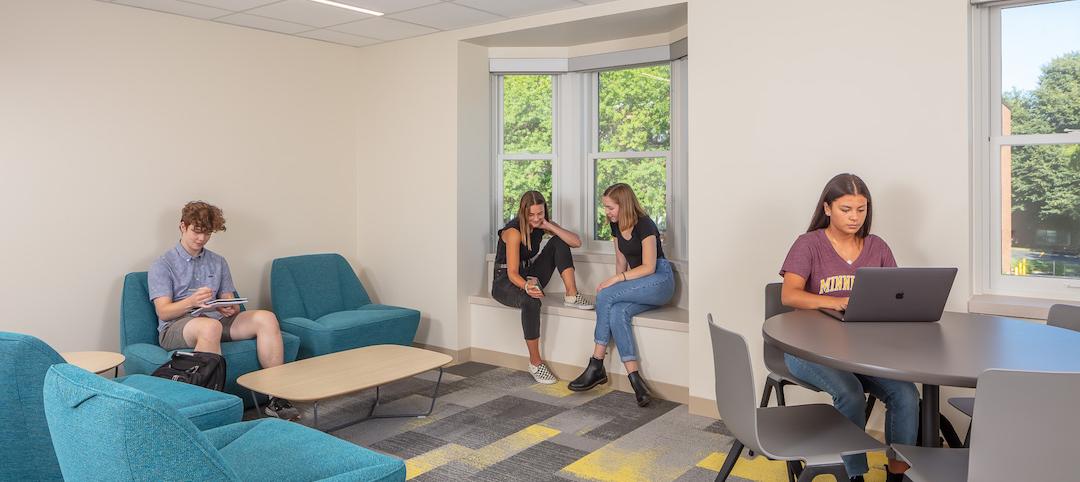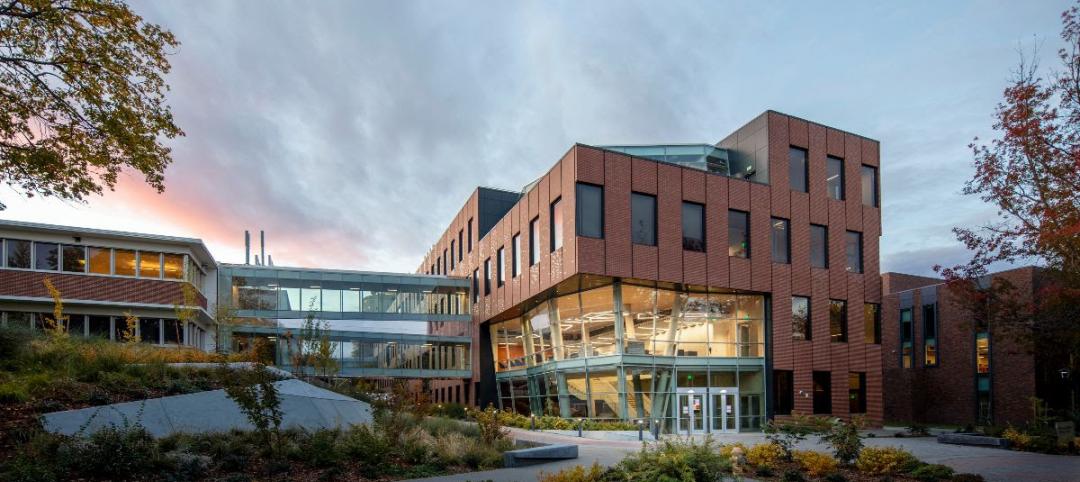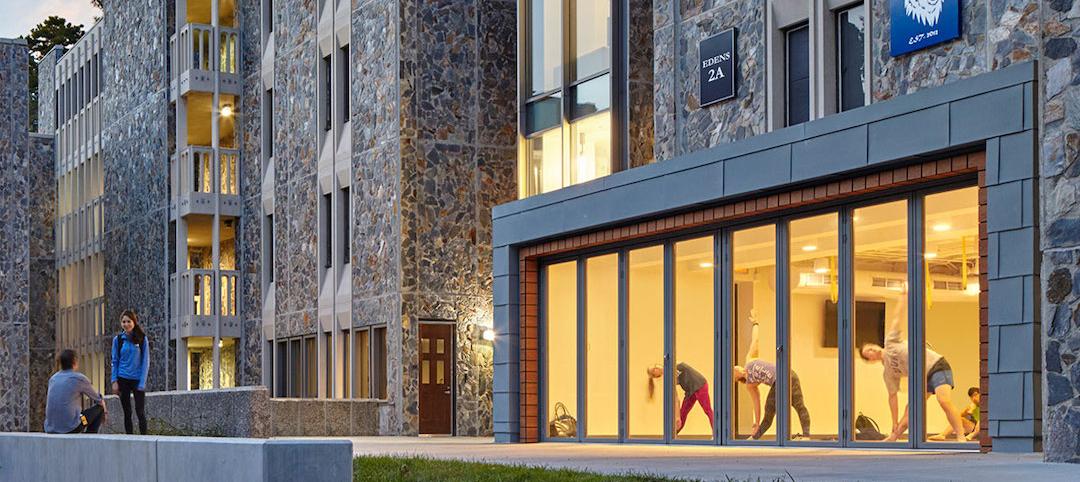Over a five-day stretch last December, students at the Carroll School in Lincoln, Mass., witnessed the installation of a modular classroom building like no other.
The new 950-sf structure, which will serve as the school's tutoring offices for the next few years, is loaded with sustainable features like sun-tunnel skylights, doubled-insulated low-e glazing, a cool roof, light shelves, bamboo trim, low-VOC materials, daylight and occupancy sensors, and a quiet, high-efficiency ventilation system.
The relocatable classroom, named SmartSpace by its creators, is one of a number of high-performance modular classrooms to emerge on the market during the last few years, and it's the first LEED-level unit to be installed in the U.S.
“With SmartSpace, we wanted to rethink typical modular design and construction approaches for classroom buildings,” says Mark N. Dolny, AIA, senior associate with ARC/Architectural Resources Cambridge, which teamed with modular manufacturer NRB Inc., Ephrata, Pa., and Littleton, Mass.-based modular leasing company Triumph Leasing Corp. to develop the SmartSpace design.
Dolny says simple additions like a double-door entry vestibule and expansive exterior glazing (6x16 feet) go a long way toward reducing energy consumption and improving the interior classroom environment.
“Most modular classrooms don't have vestibules, so conditioned air instantly leaks out when people come and go,” says Dolny. A recent energy study of SmartSpace conducted by The Hickory Consortium, Harvard, Mass., confirms the team's theory on the importance of vestibules: “It was one of the biggest factors in the energy study,” says Dolny, adding that the unit beat Massachusetts state energy code by 56% during testing.
The SmartSpace team was careful to keep the concept “realistic and reasonable” as it pertains to first cost, shipping logistics, and constructability, according to Philip L. Laird, AIA, principal with ARC, who collaborated on the design.
“We wanted to make sure this was a doable project and not just a pretty poster that got stuck in a drawer somewhere,” says Laird. “The solution had to be something that NRB could easily build in its shop and ship to the site.”
To that point, the design team worked closely with NRB and Triumph to stay within the size constraints and material specifications for a typical modular classroom. Common materials such as corrugated steel siding, medium-density fiberboard walls, and TPO roofing were specified over more complicated, labor-intensive solutions, like vegetated roofing. Also, dimensions were limited to 25 feet wide, 38 feet long, and 15 feet high to ease shipping to the site and installation. The building is shipped in two pieces. Once connected, the structure is strong enough to permit relocation of the classroom in one piece.
The team also excluded exotic technologies like solar and wind power for fear that school districts would balk at the higher first cost.
“We played with the idea of taking the building completely off the grid with photovoltaics, but PVs are still an expensive technology,” says Dolny. The fact that many modular classrooms are leased works against solar and wind power, he says. “If school districts are leasing, they don't have a 20-year payback to work with, and they can't get tax credits or grants to help pay for the systems.”
Project FROG makes leaps in California
In California, another high-performance modular classroom venture, Project FROG (BD+C May 2006, p. 9), is making inroads of its own.
The company is working on its first installation, a 9,500-sf child development center at the City College of San Francisco, to be completed this summer. The development will incorporate 10 of the firm's Dragonfly and Turtle “green” modular units interconnected to form a campus with classrooms, work areas, office space, reading rooms, a preschool, and motor skills areas for both preschoolers and toddlers.
Project FROG spokesperson Nikki Tankursley says the company is in talks with several other colleges about building similar child development centers. “We've also gotten calls from major Silicon Valley corporations looking to build child development centers for their employees,” says Tankursley. “I think we're on to a nice market here.”
In addition, the company received news late last month that its modular units are now “pre-check” approved by the Division of the State Architect. That means that school districts and community colleges that wish to install Project FROG modules will get expedited permitting and approvals from the DSA.
“Having DSA PC approval tells administrators these buildings meet tough structural, life safety, and environmental standards,” said Leela Gill, COO with Project FROG, a collaboration between San Francisco-based design firm MKThink and B&H Engineering, a San Carlos, Calif.-based manufacturing firm.
The company's modular units, which range in size from 1,000 sf to 1,700 sf, also meet the high-performance school requirements of California's Collaborative for High Performance Schools program, exceed the state's Title 24 energy requirements, and are LEED certifiable. Green features include abundant daylight (up to 800 sf of glass in a single module), T5 or T8 high-efficiency fluorescent lighting, occupancy and daylight sensors, recycled acoustical ceiling tiles with a minimum NRC of 0.60, no-VOC carpet, and recycled rubber flooring.
Related Stories
Education Facilities | Jan 5, 2022
Student housing for Gen Z students will emphasize digital technology and ‘alone together’ spaces
As digitally engaged as Generation Z is, they still value and desire in-person communication and socialization.
2021 Building Team Awards | Nov 17, 2021
Caltech's new neuroscience building unites scientists, engineers to master the human brain
The Tianqiao and Chrissy Chen Institute for Neuroscience at the California Institute of Technology in Pasadena wins a Gold Award in BD+C's 2021 Building Team Awards.
Designers / Specifiers / Landscape Architects | Nov 16, 2021
‘Desire paths’ and college campus design
If a campus is not as efficient as it could be, end users will use their feet to let designers know about it.
Higher Education | Oct 26, 2021
The Interdisciplinary Science Center at Eastern Washington University completes
LMN Architects designed the building.
Cladding and Facade Systems | Oct 26, 2021
14 projects recognized by DOE for high-performance building envelope design
The inaugural class of DOE’s Better Buildings Building Envelope Campaign includes a medical office building that uses hybrid vacuum-insulated glass and a net-zero concrete-and-timber community center.
Higher Education | Sep 30, 2021
How design can support student wellness on higher ed campuses
Over the last year, the pandemic has spotlighted the importance of promoting student well-being through a holistic system of environments and resources.
Laboratories | Aug 31, 2021
Pandemic puts science and technology facilities at center stage
Expanding demand for labs and life science space is spurring new construction and improvements in existing buildings.
Giants 400 | Aug 30, 2021
2021 Giants 400 Report: Ranking the largest architecture, engineering, and construction firms in the U.S.
The 2021 Giants 400 Report includes more than 130 rankings across 25 building sectors and specialty categories.
Higher Education | Aug 30, 2021
The University of Texas at San Antonio combines its colleges of engineering and architecture
LPA Architects’ local office pushed for this to better prepare students to meet climate change challenges.
Giants 400 | Aug 26, 2021
2021 University Giants: Top architecture, engineering, and construction firms in the higher education sector
Gensler, AECOM, Turner Construction, and CannonDesign head BD+C's rankings of the nation's largest university sector architecture, engineering, and construction firms, as reported in the 2021 Giants 400 Report.
















